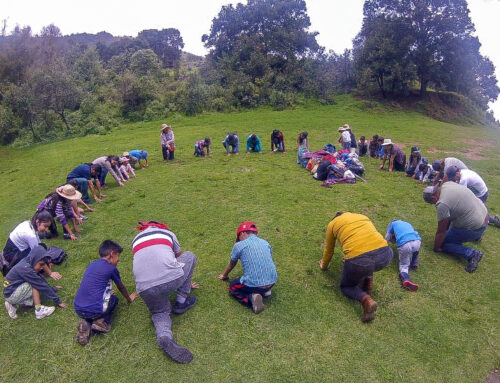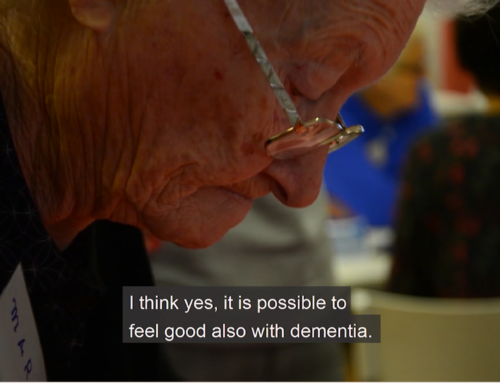Jean can’t speak words anymore.¹ The words don’t form in her mouth, always open, almost like birds that forgot how to fly and remain trapped in the open cage. It’s hard to tell whether she’s in pain or her contorted expression is just muscular stiffness due to advanced dementia. Most of the time, she’s ignored by others, an invisible presence, as if she has become part of the décor. In her file, Jean is described as loving the company of others, but there doesn’t seem to be anyone around who seeks her company.
On a Tuesday afternoon, during her Animal-Assisted Therapy visit, Laura, the volunteer, moves closer to Jean when Bonnie, the therapy-dog, approaches and starts nuzzling her. There might be some food that spilled from lunch, and when the dog pushes her nose on her chest, Jean bursts into laughter, her mouth, always open, suddenly expressing surprise and delight, continuing to smile when Bonnie tries to reach up to her chin. Her hazel eyes become focused, moving in silent conversation from Bonnie to Laura to me and the other residents and staff who are petting the dog. Sometimes Jean tries to caress Bonnie’s fur, gently grabbing her long coat. The gesture seems stiff and uncoordinated, but with an obvious aim: to pet the dog. Bonnie turns to greet Jean’s skinny fingers even when they seem to perform only unfinished, brittle gestures, cut mid-way in their intention, entering into this mute, tactile dialogue. The hand seems to remember what the mind seems to have forgotten, and when the hand is too stiff to carry its aim fully, the dog seems to remind and complete the gesture, making her body available for the hand to give a full touch. Moira, another resident at Golden Age, who never speaks to Jean even though most of the time they sit next to each other, asks her, although rhetorically: “You like dogs, don’t you?,” as if Jean suddenly materialized from her cloak of invisibility (Diary note).
During the first months of 2020, before the pandemic, and continuing throughout 2022 when the care homes in Scotland reopened, I conducted my PhD fieldwork at Golden Age Care Home, where Jean lived and Laura and Bonnie volunteered. What I wanted to learn was how domestic pets, in particular dogs, become part of the dementia care landscape through the practice known as Animal-Assisted Therapy. In Scotland, where I conducted my fieldwork, Animal-Assisted Therapy is a relatively informal practice of visiting people who live with a medical condition or in a space of social confinement, such as care homes (the place volunteers in the program visit for the first year), hospices, hospitals, schools, prisons, universities, or airports. The program is run by Canine Concern Scotland Trust charity volunteers, who are pet owners, mostly of dogs.
Rather than approaching this practice from the human or the dementia it targets, as most studies do, I chose instead to follow the dog, by paying attention to what the dog was, taking seriously Harvard canine psychologist Alexandra Horowitz’s (2012) assertion that dogs are the best anthropologists: the best observers of human behaviour. By following the dog and becoming their apprentice, I shifted my attention much more toward the sensoriality and materiality of the care home, to which dogs themselves paid most attention, learning in the process about life with dementia spent in the care environment of the home. But I also paid specific attention to–and tried to learn from how dogs were practicing–a form of what philosopher of science Vinciane Despret (2013) calls “embodied empathy:” how animals and humans can share a social space of bodily responsiveness, communication and (partial) connection when empathy–as feeling what one feels–may fall short or is ontologically obscured either by belonging to another species or being someone living with advanced dementia.
When I was speaking with some volunteers in the therapy-pet program, one thing came across quite strikingly. Most volunteers described themselves as being more of a “dog person”–or in other words, as not being very sociable and preferring to spent their time in the company of dogs. On the contrary, their dogs showed a strong interest and enjoyment in interacting with humans, being person- or human-oriented dogs, almost in an inverted form of sociality across species. Volunteers called this the dogs’ “talent,” “inclination” or “gift”: showing pleasure in approaching strangers and being petted by them (something that, contrary to general opinion, is rather rare among pet dogs.) So when they decided to volunteer in the therapy-pet program, it wasn’t always primarily because they wanted to do something good for the community (although they didn’t exclude this as a side benefit), but because they wanted to act upon their dog’s potential–which made the dog’s life better.
Most volunteers were also retired, and they saw this period in their life as a time of opening new possibilities. Getting a dog, for many, was a childhood dream never realized as “life got in the way.” But retirement also gave them the spare time to be used outwards, in the community. When they decided to do something with their dog by volunteering in the therapy-pet program, most of them didn’t have any previous experience of visiting a care home or interacting with someone with dementia. To many, both care homes and the lives of those with dementia came somehow as a shock: hidden from public view, care homes were seen as a foreclosure of meaningful life, with or without dementia, especially for those who had to rehome or put to sleep their pets when moving there. Suffering, in this sense, was more located within the confinement of the care home, as the only social and political option made available for aging with decline—and without their pets. Many saw their future selves on an ontological continuum of decline as part of life itself, though as a rather vague spectre of a future not here yet. Still, from their retired present, it felt that it was drawing near.

8-year-old German Shepherd Tweedie Bear still enjoys Therapet visits after six years of doing them with his “adoring owner,” Julie Duguid. He displays proudly the bandana and logo of Therapet, a registered trade mark of Canine Concern Scotland Trust. Photo by Becca McDonald. Used with Julie Duguid and Tweedie Bear’s permission.
Taking action, as humans, felt sometimes inhibiting and unsettling–if not paralyzing–for some volunteers. Action, the human ability to initiate and create something new in relation to others, as Hannah Arendt suggests (1998 [1958]), seemed difficult, since witnessing the suffering in the volunteer capacity was unbearable. Volunteers implied there is a limit of human empathy, and of the ability to connect and initiate connection, not least because caring too much impedes the ability to care as a long-term commitment to the program by bringing one to exhaustion. Compassion, it seemed, fell short without risking its exposure as a limited human resource for action, as understood through the concept of compassion fatigue.
With their dogs, then, it felt that the emotional burden of acting was relieved by locating action somewhere else: in the dogs’ love for inter-acting with humans, almost interspersing themselves between their owners and those they visited – physically, affectively, and temporally. That didn’t mean that volunteers did not do a great amount of work: chiefly, by supporting the dog’s action and acting when the dog was put in a potentially dangerous or stressful situation, got tired, or the environment was too overwhelming for the dog. But volunteers also engaged in conversation, answering questions about their dogs, trying to stay present throughout loops of reminiscence, or paying attention to the residents’ gestures when they could not engage in conversation and responding to them. But, they admitted, they could not have done that without their dogs, and often they followed their dog as someone who opened a door for connection that would otherwise remain shut.
In the institutional space where human care often felt fragmented and disjointed by attending to a body with an attached person whose history often remained obscured, dogs acted as glueing agents of sociality. By forging moments of connection, dogs opened worlds of care (see Arnold and Aulino 2021), by unravelling what institutional care has hidden in full sight: the person with dementia as someone with a life history, as someone made in connection.
Daisy, a resident at Golden Age Care Home diagnosed with dementia, spent most of her time by herself in the conservatory, commenting on the bustle of life around her. As someone who grew up on a croft in the Scottish Highlands, she preferred solitude, and often refused to participate in activities that she found pointless: coloring books, playing with a beach ball, or folding yarn. But when Bonnie, the therapy-dog, pushed her head through the tight space of the zimmer frame placed in front of Daisy, trying to reach out to her extended hand, she made Daisy visible through her gesture as someone who loved dogs, as a dog-person. And, in reaching out in response to Daisy’s extended calling hand, Bonnie carried along her volunteer handler, Laura, herself a dog-person, bringing them all–and sometimes other residents and staff–in this space of connection and acting in response-ability (Haraway 2008, 2016).
Following Hannah Arendt (1998 [1958]) and her focus on action as the grounding of morality, Cheryl Mattingly (2014) speaks of the moral deliberation and decision that become constitutive of moral becoming. Statistically, lives with disability, those with dementia included, are proscribed as falling short of what a good life may be–something that activists have highly contested over the years. But when experimenting with the good and what a good life with disability can look like, as Mattingly shows, these statistics are turned into potentialities that are open to new realizations.
Lives with dementia, especially in the confinement of the institutional environment of care, can, too, fall short as meaningful lives. Despite a more than three-decades long advocacy of person-centred care, the person with dementia can still remain hidden in full sight even with the best care available, or sometimes even as a way of preserving oneself within a difficult care environment, but most often it arises as an inherent limitation of what human care can offer and unveil in terms of connection.
By grafting their own actions on their dog’s inclination to act, volunteers end up “playing it by ear as they go along.” As Hannah Arendt (1998 [1958], 190) argues, however, this is not a mere reaction: “reaction, apart from being a response, is always a new action that strikes out on its own and affect others.” In acting and reacting based on their dog’s action, volunteers also tie themselves in this knot of connection, of making kin across and despite difference. As Donna Haraway (2008, 2016) would put it, making kin within and across species in the thickness of the present. Making kin, in this sense, reveals its original meaning of “birth”: it creates, following Arendt (1998 [1958]) and Mattingly (2014), a moment of natality, of a small miracle happening. Those living with dementia in care homes remind volunteers of lives that are statistically probable and deeply unsettling, as we are always reminded by big narratives of grey tsunamis, risks to dementia running havoc, and crushing numbers of cognitive decline as old age draws near. Charities in the United Kingdom morally compel us to act in the name of a shared future with dementia: either as someone who will develop it or as someone who will live with or care for someone with dementia. But these future imaginings that can make one feel paralyzed, too, in acting and witnessing what feels unbearable and temporally foreclosing. In an unsettled world in which witnessing present and imagining future suffering can exhaust empathy, acting as a way of connecting to others and creating new possibilities of good lives becomes a potent resource for moral salvage.
Acting, it may seem, does not only unstick someone from a state of emotional paralysis or self-preservation, but also morally transforms one in responding to suffering as an ontological continuum of shared vulnerability. In acting with the dogs, what is unbearable becomes not only more bearable, but also morally nascent, creating openings for new possibilities of connecting and kinship–both with humans and other species–in the thick present against fears of the future.
It may sound that such connection remains clung to the present moment as something that can easily vanish, questioning whether kinship, in this sense, becomes diluted as a long-term connection bounded by relations that are rooted in a thick past and projected future together. But, as Daisy put it when she petted Bonnie, “this makes all the difference”: making her life story visible in a choreography of care and response, and socially meaningful–to her and to others–in spite of the unsettling prospect of future decline that we may all face one day.
Notes
[1] All names, including that of the therapy-dog, have been anonymized. Real names of the therapy-dog and volunteer in the photo caption used with their permission.
Acknowledgements
This essay has been originally presented during the conference organised by Dr. Francesco Diodati, Dr. Swetlana Torno and Simone Felding, in Venice, Italy (2024) as part of the European Association for Social Anthropologists Age and Generations Network (AgeNet). I am extremely grateful to them for creating a fantastic space for conversation and intellectual camaraderie during this event. My conference participation was funded by the Foundation for the Sociology of Health and Illness through the Postgraduate International Conference Travel Award. I am very grateful for their support and for considering my paper worthy of funding.
I am extremely grateful to Magdalena Zegarra Chiappori for her invitation to develop my essay, and to her and Aaron Su for their fantastic suggestions and considerate edits of my piece.
References
Arendt, Hannah. 1998 [1958]. The Human Condition. Chicago: The University of Chicago Press.
Arnold, Lynnette. and Aulino, Felicity. 2021. “A call to care: how a focus on care can open ordinary lives, hidden in full sight.” Anthropology News website, June 23 2021.
Despret, Vinciane. 2013. “Responding bodies and partial affinities in human–animal worlds.” Theory, Culture & Society, 30 (7-8): 51-76.
Haraway, Donna. 2008. When Species Meet. Minneapolis: University of Minnesota Press.
Haraway, Donna. 2016. Staying with the Trouble: Making Kin in the Chtulucene. Durham: Duke University Press.
Horowitz, Alexandra. 2012. Inside of a Dog: What Dogs See, Smell, and Know. New York: Scribner.
Mattingly, Cheryl. 2014. Moral Laboratories: Family Peril and the Struggle for a Good Life. Oakland: University of California Press.
Cristina Douglas is a post-doctoral research associate at the University of Edinburgh (Centre for Clinical Brain Sciences, College of Medicine and Veterinary Medicine). Her research focuses on more-than-human relations in later life and mental health, ethics in dementia research, and more-than-human ethics. She co-edited, with Dr. Andrew Whitehouse (University of Aberdeen), the volume More-than-human aging: Animals, robots, and care in later life (in press at Rutgers University Press)
Cite as: Douglas, Cristina. 2024. “(Un)settling action: Making sense of dementia in more-than-human moral worlds” In “Aging Globally: Challenges and Possibilities of Growing Old in an Unsettling Era,” edited by Magdalena Zegarra Chiappori, American Ethnologist website, 7 August 2024. [https://americanethnologist.org/online-content/collections/aging-globally/unsettling-action-making-sense-of-dementia-in-more-than-human-moral-worldsby-cristina-douglas/]




